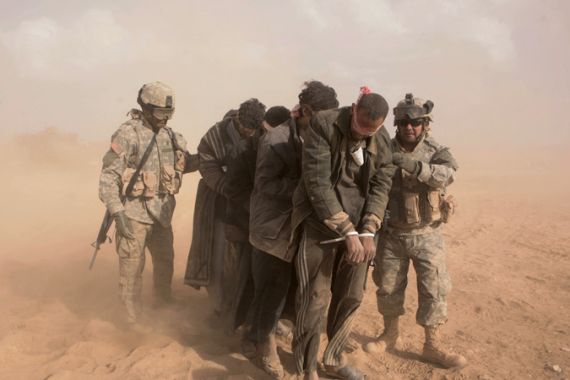
Searching for Steele
An investigation into the role played by a retired US colonel in Iraq’s US-funded sectarian interrogation units.
Editor’s note: This film is no longer available online.
Sparked by Wikileaks’ release of classified US military documents, this investigation uncovers how the Pentagon sent James Steele, a US veteran of the “dirty wars” in Central America, to oversee sectarian police commando units in Iraq that set up secret detention and torture centres to get information from fighters.
Composed of violent Shia militias, these commandos evolved into death squads and eventually numbered over 17,000 men.
General David Petraeus is also implicated in the chain of command in this abuse of human rights. Colonel James Coffman, another special forces veteran drafted in to oversee the operation, describes himself as Petraeus’ “eyes and ears out on the ground” in Iraq.
“They knew everything that was going on there, the most horrible kinds of torture,” says General Muntadher al-Samari, speaking for the first time about the US role in the interrogation units. Ten years on from the invasion, the long-term effect this paramilitary force has unleashed is a deadly sectarian militia that has helped germinate a civil war claiming tens of thousands of lives.
FILMMAKER’S VIEW
By Maggie O’Kane
When the Wikileaks documents came out in November 2010, there was one leak in particular that caught my attention. It referenced “Frago 242”, which was short for “Fragmentary Order 242” – a US military order instructing US soldiers to ignore Iraqi-on-Iraqi torture.
Along with the team I work with, I found that the term “Frago 242” appeared more than a thousand times in the documents we examined. Having spent a lot of time covering the war in Iraq, we naturally wondered why this order was issued and what the story behind it was.
Our investigation uncovered how a retired US Colonel, James Steele, was overseeing Pentagon-backed death squads that tortured detainees for information on the armed groups. There were also references in the Wikileaks files to a General Adnan Thabit, who was visiting the American embassy at the time.
We all sensed that there was a much deeper story to tell than the means by which the documents had been delivered, and resolved to explore the treasure trove we believed these documents to be.
For me, the most surprising aspect was the scale of the torture and just how well organised it was.
During the course of our investigation, I came to realise just how, as journalists, during the fog of war, we never really seem to report on what is happening in a way that people can fully comprehend. Sure, there were reports that torture was taking place, but it somehow never completely penetrated our consciousness and it was never fully acknowledged that this was part of how the war was being conducted.
This film taught me that, while we freely use terms such as “human intelligence” and “counterinsurgency”, we do not necessarily appreciate what these imply in terms of systematic and brutal torture with severe repercussions for civilians.
The Iraq war is indicative of a very dysfunctional, brutal time. I hope this film will be a legacy that says: If you want to go to war, this is what war means. It means 14-year-old boys being hung up and tortured, it means men being turned on spits – that is your “counterinsurgency”. I feel it is important that this information comes out and I am shocked that we want to forget it so quickly.
This film was first broadcast on Al Jazeera English in September 2013.